Explore Can Tho - South Vietnam Travel, Asia
Can Tho, the vibrant heart of Vietnam's Mekong Delta, beckons travelers with its lush landscapes and lively culture. Located in southern Vietnam, this charming city is the largest in the delta region and serves as a gateway to the area’s unique waterways and floating markets. Known for its picturesque riverside views and warm hospitality, Can Tho offers a rich tapestry of experiences, from bustling markets to serene boat tours.
Population: Approximately 1.5 millions in 2024.
Economy: With two industrial parks and a sizable freshwater port, the city has developed over the course of 120 years to become the delta's most significant hub for economy, culture, science, and technology.
Landmarks: Famous for the Cai Rang Floating Market, Binh Thuy Ancient House, and Can Tho Bridge.
Vietnam
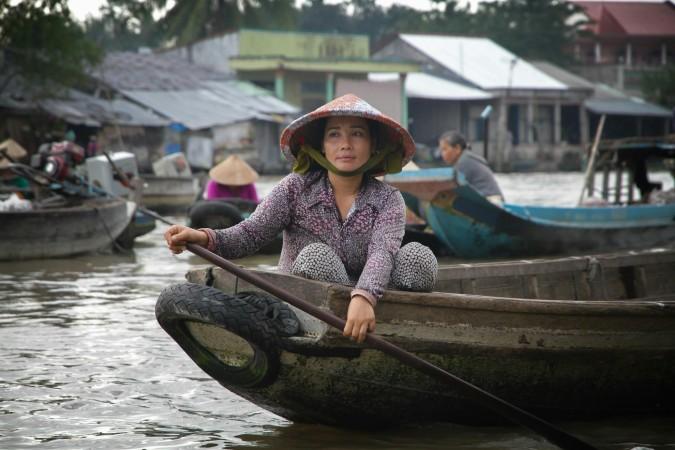
Overview of Can Tho
History & Cultural Influence
Can Tho's history is a tapestry woven with the threads of various cultural influences. Originally a small river town, it has grown into a bustling city while preserving its traditional charm. The region was significantly impacted by the French colonial period, which left an imprint on its architecture and urban layout. Cultural influences from the Khmer and Cham civilizations are evident in local festivals, crafts, and temples. This blend of traditions creates a unique cultural atmosphere, making Can Tho a living museum of Vietnam’s rich past.
All our tours in Vietnam are managed and operated by experienced guides. Check out our best tour in Vietnam here.
Interaction with The Locals
Can Tho, a bustling city in Vietnam’s Mekong Delta, has a population of approximately 1.5 million people. The city's residents are a diverse mix of ethnic Vietnamese and various minority groups, contributing to its rich cultural tapestry. Can Tho’s citizens are known for their warmth and hospitality, making visitors feel welcome as they explore the city’s vibrant markets, historical sites, and scenic waterways. This dynamic population adds to the city’s charm and offers an authentic glimpse into life in the Mekong Delta.
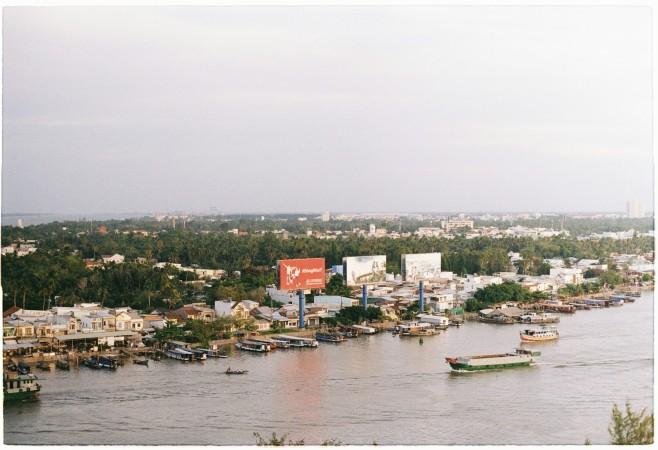
Ninh Kieu, Can Tho - © Tan Dao
Top Attractions in Can Tho
Must-See Sights in Can Tho
- Cai Rang Floating Market: The Cai Rang Floating Market is a lively spectacle of commerce on water, where local vendors sell fresh produce, flowers, and traditional snacks from their boats. Arrive early to witness the market in full swing and enjoy a unique breakfast experience with local dishes like bánh cuốn (steamed rice rolls) and fresh fruit.
- Binh Thuy Ancient House: This historical house, dating back to the 19th century, is a well-preserved example of traditional Vietnamese architecture. The Binh Thuy Ancient House is known for its intricate wooden carvings, ornate furniture, and beautiful garden, offering insights into the life of the wealthy Chinese-Vietnamese family who once lived here and a rich cultural context in the lifestyle of the past.
- Can Tho Bridge: The Can Tho Bridge, which crosses the Hau River, is a feat of engineering and a representation of the industrialization of the city. Whether you’re crossing it by car or taking a leisurely walk along its pedestrian path, the Can Tho Bridge provides a striking perspective of the Mekong Delta’s natural beauty and urban development.
Hidden Gems in Can Tho
- Phong Dien Floating Market: A lesser-known destination by tourists compared to Cai Rang, the Phong Dien Floating Market offers a more authentic and tranquil market experience. The slower pace and smaller size of this market make it an excellent spot for a more personal interaction with vendors and a deeper understanding of local life.
- My Khanh Tourist Village: My Khanh Tourist Village is a family-friendly destination that combines cultural education with fun activities. The village also features a petting zoo with farm animals, making it a great spot for families with children. For visitors of all ages, its blend of interactive displays and cultural insights offers a thorough and enjoyable experience.
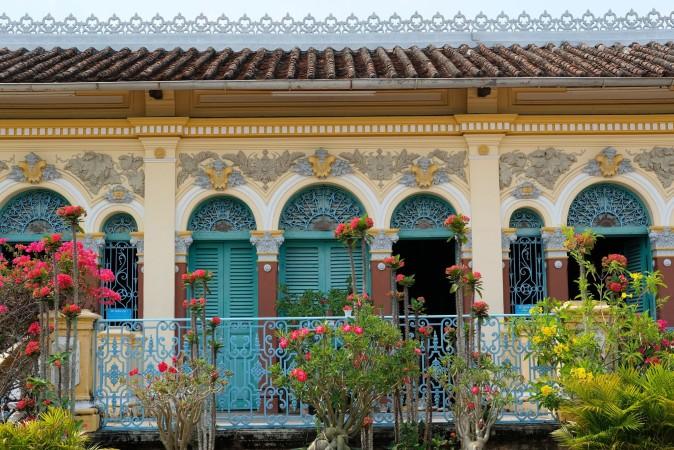
Binh Thuy Ancient House - © Tuoi Tre News
Must-Try Dishes in Can Tho
- Hu Tieu (Vietnamese Rice Noodles): A savory noodle soup, Hu Tieu features rice noodles in a fragrant broth, often topped with shrimp, pork, and crispy shallots. It’s a versatile dish that can be enjoyed at any time of day, with options ranging from clear to slightly spicy broths.
- Nem Nuong (Vietnamese grilled pork sausage): Nem Nuong are grilled pork skewers marinated in a blend of spices and grilled until tender. Served with rice paper, fresh herbs, and a tangy dipping sauce, these skewers offer a delightful mix of flavors and textures.
- Banh Xeo (Vietnamese Pancake): Banh Xeo are crispy Vietnamese pancakes made with rice flour, turmeric, and coconut milk, filled with pork, shrimp, and bean sprouts. These savory pancakes are typically served with fresh herbs and a tangy dipping sauce.
- Com tam (Vietnamese Broken Rice): Com Tam, commonly referred to as "broken rice," is a favorite meal in Can Tho. It typically includes grilled pork chops, a fried egg, pickled vegetables, and a flavorful dipping sauce. The broken rice gives it a unique texture and a satisfying bite.
- Goi Cuon (Vietnamese Spring Rolls): Goi Cuon, or Vietnamese fresh spring rolls, are made with rice paper filled with shrimp, pork, fresh vegetables, and vermicelli noodles. They are served with a savory hoisin-peanut dipping sauce and are a light, refreshing option.
- Cha Gio (Vietnamese Egg Rolls): Cha Gio, or Vietnamese egg rolls, are crispy rolls filled with a mixture of minced pork, mushrooms, and vermicelli noodles. These are deep-fried to golden perfection and often enjoyed with lettuce and a sweet and sour dipping sauce.
Are you in love with Vietnamese cuisine? Learn more about the popular dishes in Vietnam's old capital, Hue, in this article.
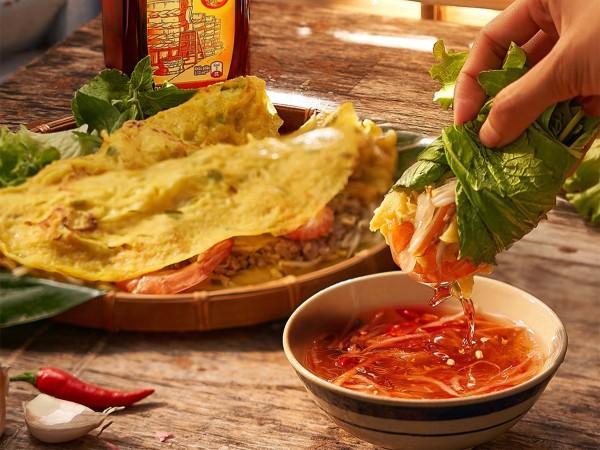
Banh Xeo (Vietnamese Pancake) - © Knorr
Festivals & Local Celebrations
Can Tho is a city that celebrates its traditions with vibrant festivals and local celebrations. These events offer a glimpse into the region’s cultural heritage and provide opportunities for visitors to join in the festivities.
Cai Rang Floating Market Festival
The Cai Rang Floating Market Festival takes place annually during the Lunar New Year and the harvest season, celebrating Can Tho’s famous floating market. The festival is a lively event where local merchants decorate their boats with colorful flags and flowers. Visitors can experience the bustling market atmosphere, enjoy local dishes cooked on the boats, and watch traditional music and dance performances that highlight the region’s cultural traditions.
Banh Xeo Festival
The Banh Xeo Festival, which takes place in Can Tho, pays tribute to the popular Vietnamese pancake. This festival, which usually takes place in late spring, showcases cooking demonstrations and tastings of Banh Xeo. Attendees can learn about the preparation of these crispy pancakes, which are filled with pork, shrimp, and bean sprouts, and enjoy various regional variations. The festival also features local entertainment, including traditional music and dance.
Nghinh Ong Festival (Whale Worshiping Festival)
The Nghinh Ong Festival, which takes place in late September or early October, is a traditional celebration honoring the whale, who is revered as the protector spirit of fisherman. The festival involves a maritime procession where locals pay respects to the whale deity. Participants offer ceremonial offerings on boats, perform traditional rituals, and join in festive activities, including folk games and traditional music.
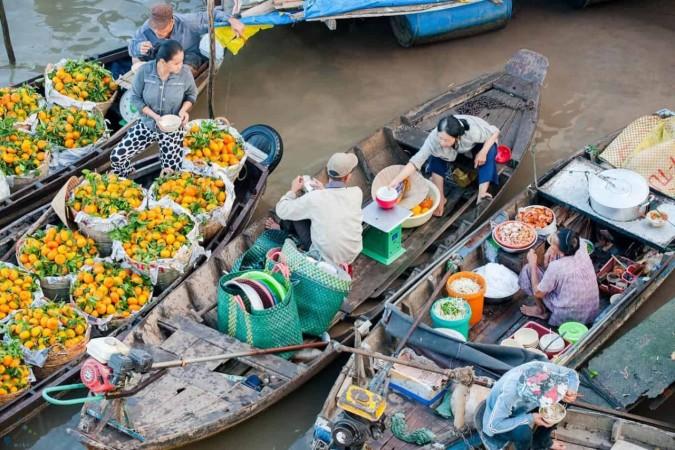
Cai Rang Floating Market Festival - © The World and Vietnam Report
What to Do in Can Tho
Can Tho offers a range of activities that cater to diverse interests, from exploring its waterways to engaging in local traditions.
- Mekong Delta Boat Tours: Experience the beauty of the Mekong Delta with a boat tour along Can Tho’s rivers. These tours offer scenic views, visits to floating markets, and insights into the local way of life. It’s a relaxing and immersive way to explore the region.
- Can Tho Cycling Tours: Discover the countryside around Can Tho on a cycling tour. Pedal through lush landscapes, visit local farms, and enjoy the fresh air while exploring rural areas that are often missed by conventional tours.
- Vietnamese Cuisine Cooking Classes: Take a cooking lesson to discover how to make authentic Vietnamese cuisine. Many local chefs offer classes that include market tours and hands-on cooking experiences, providing a deep dive into Can Tho’s culinary culture.
- Mekong River Cruises: Enjoy a leisurely river cruise to witness the tranquil beauty of the Mekong Delta region. These cruises offer stunning views of the landscape and are often accompanied by traditional music and dining experiences.
- Spa and Wellness: Unwind with a relaxing spa treatment at one of Can Tho’s wellness centers. Many spas offer traditional Vietnamese massages and therapies, perfect for rejuvenating after a day of exploration.
Shopping in Can Tho
Can Tho’s shopping scene offers a mix of traditional markets and modern retail options, making it easy for visitors to find unique souvenirs and local products.
- Can Tho Night Market: A bustling marketplace where you can shop for souvenirs, local crafts, and street food. The Can Tho Night Market is known for its vibrant atmosphere and variety of goods, including handicrafts, textiles, and traditional Vietnamese items.
- Ninh Kieu Market: Located near the city center, Ninh Kieu Market is a great place to purchase fresh produce, local snacks, and handcrafted goods. It’s a popular spot for both tourists and locals, offering a wide range of items at reasonable prices.
- Local Handicrafts: Look for traditional Vietnamese crafts such as silk scarves, lacquerware, and pottery. These items make memorable souvenirs and reflect the region’s artisanal heritage.
- Mekong Delta Specialty Stores: The Mekong Delta is known for its agricultural products, so consider buying local specialties like dried fruits, coconut candy, and rice wine to take home as gifts. Mekong specialities can be found in many local areas in this region.
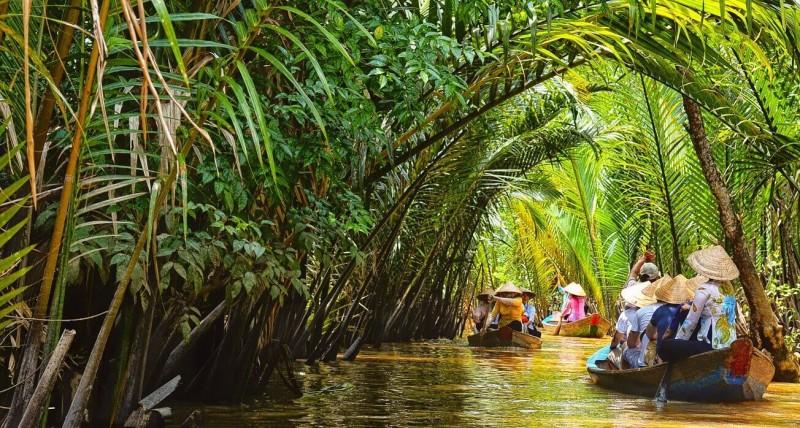
Mekong Delta Boat Tours - © Vietnam Tourism
Weather in Can Tho: Best Time to Visit
Understanding Can Tho’s weather patterns is essential for planning your visit. The city experiences a tropical climate with distinct wet and dry seasons, each offering a unique experience.
Dry Season in Can Tho
- Weather: In Can Tho, the dry season (December to April) is marked by reduced humidity and little precipitation. Daytime temperatures typically range from 25°C to 35°C (77°F to 95°F), creating warm and sunny conditions ideal for outdoor activities. Since evenings provide a pleasant respite from the heat of the day, they are more enjoyable.
- Tourism Trend: This period is the most popular time to visit, as the clear skies and favorable weather allow for exploring the city’s attractions, floating markets, and river cruises. However, as it’s peak tourist season, expect more crowds and higher prices for accommodation and tours.
The dry season is the perfect period to visit southern Vietnam regions, including My Tho. Read our article about My Tho here.
Wet Season in Can Tho
- Weather: May to November is considered the rainy season; during this time, there are lots of rain showers and high humidity. During this time, temperatures range between 24°C and 32°C (75°F to 89°F). Rainfall is typically heavy but intermittent, with brief downpours often followed by sunshine. Because of the high amounts of humidity, it feels warmer than it is.
- Tourism Trend: Despite the rain, the wet season offers lush, green landscapes and fewer tourists, creating a more serene travel experience. Be prepared for occasional flooding in low-lying areas, and consider carrying a lightweight rain jacket or umbrella.
Best Time to Visit Can Tho
The optimal time to visit Can Tho is during the dry season, from December to April, when the weather is more predictable and ideal for sightseeing and outdoor activities. The pleasant conditions enhance your experience at the city’s attractions and markets. If you prefer a quieter visit and don’t mind occasional rain, the wet season can also be enjoyable, offering a different perspective of Can Tho’s natural beauty and local life.
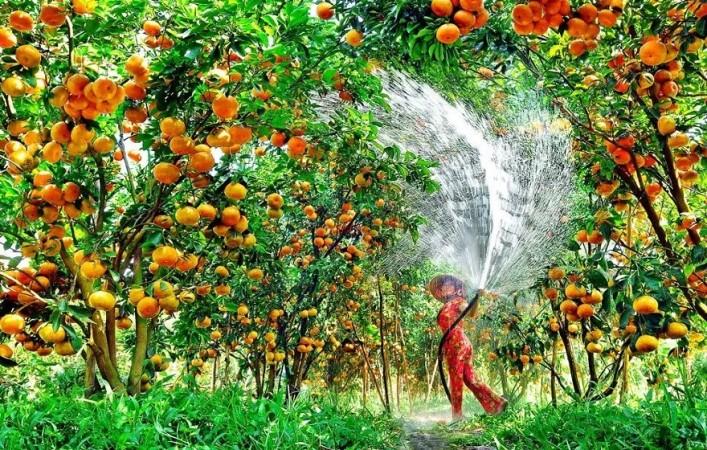
Dry season in Can Tho made the best oranges - © Vietnam Tourism
Essential Travel Information
Getting Around Can Tho
Navigating Can Tho is convenient with various transportation options catering to different needs and preferences.
- Cyclo: A traditional and scenic way to explore Can Tho is by cyclo, a three-wheeled pedal-powered vehicle. It’s perfect for short trips around the city and provides a relaxed way to enjoy the local sights.
- Motorbike Taxis (Xe Om): Motorbike taxis are a popular and efficient option for quick travel within the city. They are ideal for short distances and offer a flexible and affordable way to navigate Can Tho.
- Buses: Can Tho has a network of public buses that connect key areas of the city. Buses are an economical choice for traveling longer distances and are well-suited for budget-conscious travelers.
- Boats: Given Can Tho’s network of rivers and canals, boat rides are a common mode of transport, especially for reaching floating markets and exploring the delta. You can hire private boats or join guided tours.
- Taxis and Ride-Sharing: Traditional taxis and ride-sharing services like Grab are available in Can Tho, offering a convenient and comfortable way to travel across the city.
ATM & Banking Services
Accessing banking services in Can Tho is straightforward with a variety of options available for both locals and tourists. Numerous banks provide services including cash withdrawals, currency exchange, and account management. ATMs are prevalent throughout the city, particularly in popular areas like the city center and shopping districts, and most accept international credit and debit cards for convenient cash withdrawals. While credit and debit cards are widely accepted in hotels, restaurants, and larger shops, smaller vendors and street food stalls may only accept cash.
Where to Stay in Can Tho
Can Tho offers a diverse range of accommodation options to cater to various preferences and budgets, from luxurious hotels to cozy guesthouses. For those seeking luxury, there are upscale hotels along the Hau River that blend modern amenities with traditional Vietnamese charm, featuring spacious rooms, large pools, and multiple dining options. Mid-range hotels provide comfortable stays with well-furnished rooms, restaurants, and fitness centers, conveniently located for exploring the city. Budget travelers can choose from guesthouses and hostels that offer basic amenities and a more local experience. Additionally, homestays are available, providing an authentic glimpse into daily life in Can Tho and the opportunity to experience local hospitality.
Articles for you

Explore Yala National Park - Sri Lanka Travel, Asia
Tucked away in Sri Lanka’s southeastern corner, Yala National Park is where wild nature meets deep tradition. Known worldwide for its leopard population, the park is also home to elephants, sloth bears, crocodiles, and hundreds of bird species. Beyond wildlife, Yala opens doors to a cultural landscape dotted with ancient temples, Buddhist ruins, and coastal villages. For travelers seeking more than just a safari, Yala offers a chance to explore eco-tourism, local communities, and sacred heritage sites.
Population: The Yala National Park area doesn’t have a human population.
Economy: The economy around Yala National Park thrives on a blend of eco-tourism, agriculture, and local services. Safari tours, eco-lodges, and cultural experiences drive steady income for nearby towns like Tissamaharama and Kataragama, supporting thousands of families.
Landmarks: Famous for Block I of Yala and wildlife encounters, including elephants, sloth bears, crocodiles, and exotic bird species.

Explore Galle - Sri Lanka Travel, Asia
Nestled on Sri Lanka’s southern coastline, Galle is a vibrant city where history meets the sea. Its cobbled streets, colonial architecture, and serene beaches make it a must-visit destination for travelers seeking a blend of culture, adventure, and relaxation. A UNESCO World Heritage site, Galle captivates visitors with its Dutch Fort, bustling markets, and friendly locals. Whether you’re exploring the ramparts at sunset or savoring fresh seafood by the shore, Galle promises an unforgettable journey into Sri Lanka’s heritage.
Population: Approximately 113,000 in 2023.
Economy: Galle’s economy thrives on tourism, trade, and fisheries. The city’s historic fort, colonial architecture, and coastal charm draw thousands of international visitors each year, making tourism its main economic driver. Fishing remains vital for local livelihoods, supplying fresh seafood across the region.
Landmarks: Famous for the Galle Fort, Dutch Reformed Church & Maritime Museum, and Unawatuna Beach.

Explore Bentota - Sri Lanka Travel, Asia
Nestled along Sri Lanka’s southwestern coast, Bentota is a tropical paradise that blends golden beaches, vibrant culture, and thrilling adventures. Famous for its calm waters, luxury resorts, and scenic river estuary, Bentota has become a top destination for travelers seeking both relaxation and authentic experiences. From serene beach walks at sunrise to adrenaline-pumping water sports, this coastal town offers a perfect balance of leisure and exploration. With its proximity to Colombo and Galle, Bentota is easy to reach, making it an ideal stop for both short escapes and extended holidays.
Population: Approximately 37,000 in 2023.
Economy: Bentota’s economy thrives mainly on tourism, which drives local businesses such as hotels, restaurants, and wellness retreats. The town also benefits from fishing, coconut cultivation, and handicrafts like wood carving and batik textiles. Many residents rely on the growing demand for water sports and Ayurvedic treatments, making tourism the backbone of both income and employment in the area.
Landmarks: Famous for Bentota Beach, Bentota River Safari, and Kande Vihara Temple.

Explore Mirissa - Sri Lanka Travel, Asia
Mirissa is a charming coastal town on Sri Lanka’s southern shoreline. Known for its golden beaches, turquoise waters, and vibrant marine life, it has become a must-visit stop for travelers exploring the island. Many come for whale watching, surfing, and sunset views at Coconut Tree Hill, but Mirissa offers much more than postcard beauty. The fishing boats you see anchored by the bay carry generations of stories. Local traditions, delicious cuisine, and a laid-back rhythm of life shape every visitor’s experience.
Population: Approximately 4,700 in 2023.
Economy: Mirissa’s economy is largely shaped by its coastal location. Fishing has long been the backbone of local livelihoods, with generations relying on the Indian Ocean for income. In recent decades, tourism has become the main driver of growth, thanks to whale watching, surfing, and beachside hospitality.
Landmarks: Famous for Mirissa Beach, Coconut Tree Hill, and Parrot Rock Bridge.

Explore Nuwara Eliya - Sri Lanka Travel, Asia
Tucked away in the Central Highlands of Sri Lanka, Nuwara Eliya is often called “Little England”. With its rolling tea plantations, cool misty mornings, and colonial charm, this mountain town feels like a step into another world. Travelers come here to breathe fresh air, walk through flower gardens, sip the finest Ceylon Tea, and enjoy a pace of life far from the island’s busy cities. Whether you’re drawn by scenic landscapes, heritage architecture, or the warmth of its people, Nuwara Eliya is a destination that blends nature, culture, and history in perfect harmony.
Population: Approximately 781,000 in 2023.
Economy: Nuwara Eliya’s economy thrives mainly on tea production, as it sits in the heart of Sri Lanka’s central highlands, famous worldwide for Ceylon Tea. The city also benefits from a growing tourism industry, attracting visitors with its colonial charm, cool climate, and scenic landscapes.
Landmarks: Famous for Gregory Lake, Hakgala Botanical Garden, and Victoria Park.

Explore Sukau - Malaysia Travel, Asia
Nestled on the banks of the Kinabatangan River in Sabah, Malaysian Borneo, Sukau is a destination where wildlife, culture, and conservation come together. Known as one of Asia’s top spots for river safaris and eco-tourism, this quiet village offers a front-row seat to encounters with Bornean orangutans, pygmy elephants, proboscis monkeys, and exotic birdlife.
Population: Approximately 1,400 in 2019.
Economy: Sukau’s economy is shaped by its riverine location and natural resources. Traditionally, the Orang Sungai community relied on fishing, small-scale farming, and forest gathering for their livelihood. Today, the village has shifted toward eco-tourism, with river cruises, jungle trekking, and homestays providing income.
Landmarks: Famous for the Kinabatangan River cruises, Gomantong Caves, and Ox-bow lakes and wetlands.
